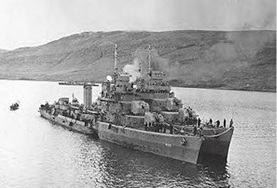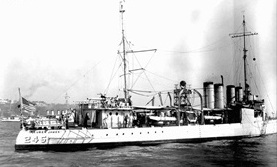U-BOAT TORPEDOES U.S. WARSHIP
Washington, D.C. • October 17, 1941
Starting on September 1, 1941, two years into the Battle of the Atlantic, U.S. warships began escorting convoys of Britain-bound merchantmen from the North American coast. Convoys departed from Newfoundland off the coast of Canada and ended in the mid-Atlantic at Iceland, a Danish possession whose defense the U.S. had assumed on July 7, 1941. Four days after initiating the escort service, the U.S. destroyer Greer, bound for Iceland with a load of mail, was attached by a German submarine 175 miles southwest of that island and, in responding to the attack, damaged it. The “Greer incident” led President Franklin D. Roosevelt to issue what became known as his “shoot-on-sight” order. “From now on,” the president warned America’s Axis adversaries, “if German or Italian vessels of war enter the waters, the protection of which is necessary for American defense, they do so at their own peril.”
On this date, October 17, 1941, off the southwest coast of Iceland again, the Battle of the Atlantic escalated when a German U‑boat torpedoed the U.S. destroyer Kearny as it came to the rescue of a Canadian-escorted convoy. Eleven U.S. crewmen were killed and twenty-two wounded. A British destroyer was also sunk in the same attack. The attacker, U‑568, was a part of a wolf pack that had been harassing British and Canadian transatlantic convoys for some time. The USS Kearny, which had been launched only the year before, was the second U.S. Navy ship since World War I to be fired on and hit. (The U.S. river gunboat USS Panay, which served to protect American interests on the Yangtze River in China, was sunk off the Chinese capital of Nanking (Nanjing) by Japanese aircraft in mid-December 1937 and may be considered the first U.S. naval casualty of World War II.)
Ten days after the Kearny attack, FDR told Americans that the country would not take the incident “lying down.” “America has been attacked,” the president said, but he didn’t seek an immediate declaration of war; instead, he asked Congress for authorization to arm American merchant vessels and allow them to enter combat zones, measures forbidden by U.S. Neutrality Acts that the U.S. Congress had passed in 1937–1939. In early November, after the old four-stacker USS Reuben James was torpedoed off Iceland on October 31, 1941, sinking in minutes with a loss of 115 lives, including all of its officers, Congress complied with the president’s request. The U.S. and Germany were now involved in an unofficial war at sea. And that’s where things stood between the two powers until December 11, 1941, when Germany declared war on the United States as a gesture of solidarity with its Axis-treaty partner Japan.
![]()
The U.S. Navy on the Eve of War with Germany, 1941
 |  |
Right: USS Kearny at Reykjavík, Iceland, two days after she had been torpedoed by U‑568. The USS Monssen is alongside. Though hard to see in this photograph, the torpedo hole is in the Kearny’s starboard side. The Kearny, assisting three other U.S. destroyers, came to the rescue of a beleaguered convoy whose Canadian escorts were being mauled by a U‑boat wolf pack when it came under attack. Casualties among Kearny’s crew included 11 dead and 22 injured. In FDR’s Navy Day speech on October 27, 1941, the former Undersecretary of the Navy and now president announced, “The shooting has started and we Americans have taken our battle stations.”
![]()
Left: The USS Reuben James—a four-funnel, post-World War I destroyer—was sunk by U‑552 west of Iceland as she escorted an eastbound convoy sailing from Newfoundland. A torpedo hit the forward section of the Reuben James. When a magazine exploded it blew off the ship’s entire bow, which sank immediately; the aft section sank five minutes later. Of the 159-man crew, only 44 survived. Counting the conflict in China, the Reuben James was the second U.S. Navy ship sunk by hostile action in World War II. The river gunboat USS Panay, serving on the Yangtze Patrol in China, was bombed, strafed, and sunk by Japanese aircraft on December 12, 1937, with a loss of 4 dead and 43 sailors and 5 civilians wounded.
Battle of the Atlantic, 1939–1945
![]()

 History buffs, there is good news! The Daily Chronicles of World War II is now available as an ebook for $4.99 on Amazon.com. Containing a year’s worth of dated entries from this website, the ebook brings the story of this tumultuous era to life in a compelling, authoritative, and succinct manner. Featuring inventive navigation aids, the ebook enables readers to instantly move forward or backward by month and date to different dated entries. Simple and elegant! Click
History buffs, there is good news! The Daily Chronicles of World War II is now available as an ebook for $4.99 on Amazon.com. Containing a year’s worth of dated entries from this website, the ebook brings the story of this tumultuous era to life in a compelling, authoritative, and succinct manner. Featuring inventive navigation aids, the ebook enables readers to instantly move forward or backward by month and date to different dated entries. Simple and elegant! Click 











